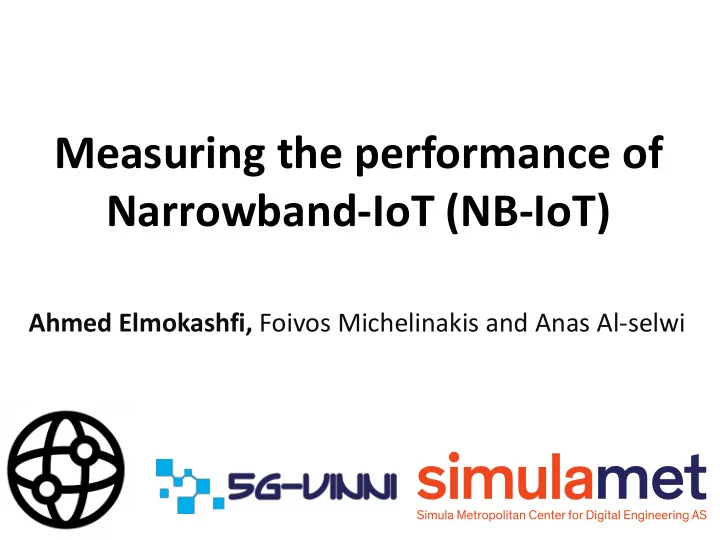

Measuring the performance of Narrowband-IoT (NB-IoT) Ahmed Elmokashfi, Foivos Michelinakis and Anas Al-selwi
IoT applications have diverse requirements Shorter to medium battery life Battery life 5-10 years Ubiquitous outdoor coverage Medium coverage Some mobility Some mobility Medium to high reliability Latency in order of seconds Latency < 10 seconds Battery life 10-15 years Mains powered Outdoor and deep indoors (+20dB) Outdoor and indoors Stationary Stationary Medium to high reliability low to high reliability Latency 10 to 60 seconds Latency < 30 seconds 2 GSMA white Paper. 3GPP Low Power wide Area Technologies
Mobile-IoT must be scalable, energy efficient and ubiquitous 3
3GPP Release 13 standardized two 3GPP Release 13 standardized two solutions for current and future IoT solutions for current and future IoT NB-IoT NB-IoT eMTC eMTC LTE Cat. NB LTE Cat. M1 LTE Cat. NB LTE Cat. M1 Deployment In-Band LTE, guard- In-Band LTE Deployment In-Band LTE, guard- In-Band LTE band LTE and band LTE and standalone standalone Bandwidth Bandwidth 180 KHz 180 KHz 1.08 MHz 1.08 MHz Peak data rate Peak data rate ~150 kbps ~150 kbps 1 Mbps 1 Mbps Latency Latency 1.6s-10 s 1.6s-10 s 10-15 ms 10-15 ms Max UE tx power Max UE tx power 23 or 20 dBm 23 or 20 dBm 23 or 20 dBm 23 or 20 dBm Power Saving Power Saving PSM, eDRX PSM, eDRX PSM, eDRX PSM, eDRX Duplex Duplex Half Half Full/Half Full/Half Complexity relative Complexity relative 10% 10% 20-25% 20-25% to LTE to LTE 30 4 NOKIA. LTE-M – Optimizing LTE for the Internet of Things, 2015
NB-IoT is now deployed in several countries 5 Image source GSMA
� � � � � � � � � � � Whilst it has always been possible for a device’s application to turn its radio module off to NB-IoT has two mechanisms to help devices conserving power 6 GSMA. NB-IoT DEPLOYMENT GUIDE to Basic Feature set Requirements April 2018
NB-IoT enhances coverage by using transmission repetitions 2x repetitions translates into 3dB coverage gain § 2x repetitions results in 0.5x speed and 2x latency § 7
Early measurements of NB-IoT commercial deployments § 2 mobile operators + 2 NB-IoT modules § UDP ping every minute with packet sizes in the range 20 to 512 bytes 8
Measurements traffic pattern Connecting & sending Active paging Idle paging PSM Measurement id 9
Clear differences in energy consumption between operators and devices Operator I-Device I Operator II-Device I Operator I-Device II Operator II-Device II 0.25 0.2 Probability density 0.15 0.1 0.05 0 1 10 Energy [J] These differences can reduce battery lifetime by 6 years (assuming that we are using a CR2032 battery with 235mAh capacity and 1 activity period per day ) 10
The differences are also evident when the coverage is poor Operator I-Device I Operator II-Device I Operator I-Device II Operator II-Device II 0.6 0.5 Probability density 0.4 0.3 0.2 0.1 0 1 10 Energy [J] 11
The two operators configure power management differently Measurement id 12
The two operators configure power management differently 13 Measurement id
RTTs are mostly below 10 seconds but are characterized by wide variability Operator I-Device I Operator II-Device I Operator I-Device II Operator II-Device II 1 0.9 0.8 Fraction of packets 0.7 0.6 0.5 0.4 0.3 0.2 0.1 0 1 10 RTT (sec) 14
Achieving a similar delay may correspond to different energy consumption levels Operator I-Device I Operator II-Device I Operator I-Device II Operator II-Device II 10 9 8 7 6 Energy [J] 5 4 3 2 1 0 1 10 15 RTT (sec)
RTT variability can partially be attributed to differences in coverage Operator I-Device I Operator II-Device I Operator I-Device II Operator II-Device II 200 150 100 SNR (dBm) 50 0 -50 -100 -150 1 10 RTT (sec) 16
Probability (RTT|Energy consumption) What is my What is How likely I get target battery corresponding RTTs higher than lifetime? max RTT? max? 9 0.9 Operator I-Device I Operator I-Device II 0.8 Operator II-Device I 8 Operator II-Device II Fraction of packets with RTT>x 0.7 7 Battery lifetime (years) 0.6 6 0.5 5 0.4 4 0.3 3 0.2 2 0.1 1 0 2 4 6 8 10 12 2 4 6 8 10 12 17 RTT (sec) RTT (sec)
There is a need for new metrics for describing NB-IoT reliability and performance § Several questions remain unanswered - Can we generate realistic traffic patterns? - Understand how transport protocols perform over NB-IoT e.g. COAP, MQTT § NB-IoT large parameter space makes interpreting measurements difficult - Power management timers - Repetitions 18
Recommend
More recommend